On our first trip to Africa over 15 years ago, Doug and I did an overland camping safari. Our trip took place mostly in Chobe National Park in Botswana (which is huge enough to spend a week in, easily), and our first campsite was near the banks of the Chobe River. We stopped by the famous Chobe Game Lodge while we were there, and I always thought it would be a great place to visit someday. It turned out to be one of the three places Doug found in southern Africa that would accept five-year-old children, and so we decided to pay it a visit.
The lodge was made famous in the 1950s as the place where Elizabeth Taylor and Richard Burton got married for the second time. (There's even a framed copy of their Botswana marriage license on display.) It fell into disrepair in the 1970s, but was refurbished and reopened in the 1980s. It's very special because it's the only permanent structure allowed in the entire park.

Beautiful tawny eagle
Cape buffalo. Old bulls like this one often live solitary lives away from the herd, since the younger males chase them off.
The lodge was made famous in the 1950s as the place where Elizabeth Taylor and Richard Burton got married for the second time. (There's even a framed copy of their Botswana marriage license on display.) It fell into disrepair in the 1970s, but was refurbished and reopened in the 1980s. It's very special because it's the only permanent structure allowed in the entire park.
I took a lot of pictures of this pool, but the water was a bit cold and we never went swimming in it.
The lodge is situated on the banks of the Chobe River, and we could often see animals coming down to the river to drink.
Groups of banded mongeese strolled the grounds, looking for insects.

We had some lovely dinners while staying here. One night we had dinner in the Boma, which is an outdoor eating area that most camps have. On this particular night, there was a marimba band playing, and Carter was so entranced by the music that he decided to get up and dance. For a long time, he was the only one dancing, but then some other people decided to join him, and then some of the staff joined, and it turned into a dance party!
The quality of those photos isn't great -- I took them with my phone at night, of course. On another evening, we had a private dinner on a platform out by the river. It was a lovely night with incredible views of the stars. In this part of Africa, there is so little light pollution that you can see the Milky Way streaking across the sky, and so, so many stars. If you've never been out of the northern hemisphere, you've never seen a night sky like this. It's something like what you grandparents or great grandparents would have seen a century ago, before cities light up our skies and drowned out the light. It's magnificent.
Unfortunately, I missed the entire first day of our time here because I was still recovering from food poisoning. On the first night, Doug and Carter went on a game drive without me, and the next morning Doug went alone and let me and Carter sleep in. By the afternoon of that day, I was feeling good enough to go out, and so I joined them for an evening boat ride.
Unfortunately, I missed the entire first day of our time here because I was still recovering from food poisoning. On the first night, Doug and Carter went on a game drive without me, and the next morning Doug went alone and let me and Carter sleep in. By the afternoon of that day, I was feeling good enough to go out, and so I joined them for an evening boat ride.
Boat rides are one of the really special activities at Chobe. Many safari camps on rivers have boat excursions, but you generally don't see very much other than birds. At Chobe, however, the boat rides can be just as exciting as a game drive, especially during the dry winter season when it's the main source of water for the animals.
Crocodiles are a very common sight along the banks of the river.
On a boat, it's possible to get a lot closer to them than you ever could on land.
The texture of their skin is amazing!
We also saw a lot of hippos, in and out of the water.
We also saw lots of elephants from the boat, in small groups and large ones.
One of the very special things you get to see at Chobe is a herd of elephants crossing the river. Surprisingly enough, elephants are very good swimmers and will cross the river to get to food on the other side. The larger elephants make sure the smaller ones are in the middle for protection from crocodiles, and the little ones will grab their mom's tail with their trunk to hang on for a ride.
I love the way they use their trunks as snorkels!
And of course, there is a lot of bird life along the edges of the water. This is a goliath heron, I believe.
Saddle-billed storks.
One evening we saw a large herd of Cape buffalo at the edge of the river.
This is a sable antelope.
We even came across some lions hunting at the water's edge! (They didn't have any luck.)
Carter really enjoyed the boat rides. These were the outings where he never seemed to get bored, for some reason.
Our guide, Maude, took good care of us. I somehow didn't get a picture of all of us together, as I did in other places. These are the only ones I have. She was a lot of fun and had two kids, one of whom is about Carter's age. She is interviewing soon for a job at the Disney Animal Kingdom Park in Orlando, so we wish her lots of luck for that! (Apparently they have a special program where they bring people over from African countries to spend a year working at the resort.)
We also did several game drives in Chobe. This park is famous for elephants, and has around 65,000 of them -- which represents nearly a quarter of Africa's total population of wild elephants.
The elephants in Chobe were much more relaxed than the ones in Madikwe were, and so we were able to observe them much closer.
They're really amazing creatures. Their social structure is matriarchal, with the largest and oldest female heading up a family group of related females. Young males are kicked out of the group when they reach sexual maturity around the age of 13, but females tend to stay with their mother, aunts, and sisters for life. Babies are highly protected and also nurse for up to four years -- equivalent to humans nursing until the age of six or seven.
And they will eat pretty much any kind of plant. They're huge animals and they can absolutely destroy their environment, and it's a massive problem for Chobe.
Notice anything unusual about the elephants in the picture below?
There are several adults in this group who don't have tusks. It's a genetic abnormality that has always occurred in elephants, but because of poaching in the last couple of centuries, it's been selected for more and more. In other words, since so many human beings have slaughtered elephants for their tusks, elephants without tusks have had an advantage, and so their numbers are increasing. In some parts of Africa, the population of tuskless elephants is up to 10%. Evolution at work.
The greater kudu is one of the largest antelopes in Africa. The females look like this:
The male, as was noted in an earlier post, has an amazing set of spiral horns.
Chobe is also a good place to see large numbers of giraffe together. (A group of giraffe is called a "journey.")
Waterbucks sparring.
They are beautiful antelopes, and are so fuzzy they look a bit like reindeer!
These vultures are waiting for the lions to turn their backs on their kill, just for a minute.
Lions are my eternal favorite. I love cats anyway, but there is something about lions that always gets my blood pumping. They're amazing animals!
These are the tiniest cubs we saw on this trip. The mothers bring the cubs to the kill once it's safe.
I know they're vicious predators, but how cute is this?
Baboons are always entertaining. The babies are much cuter than the adults, I have to say.
These two look like they're gossiping. I love it!
We came across these baboons trying to break into a road grader.
I think this is another open-billed stork.
Beautiful tawny eagle
Cape buffalo. Old bulls like this one often live solitary lives away from the herd, since the younger males chase them off.
Another beautiful antelope.
I never get tired of seeing zebras.
Wildebeest are rare in this part of Chobe, but Tsesebe are often seen hanging out with the zebras.
Spotted hyena.
Black-backed jackal.
Hippo chilling out in an unusually dusty spot.
Carter enjoyed the game drives to an extent, but several of our drives in Chobe were on very windy days, and when it's windy, the animals tend to lay low and not move around much, since they have a hard time telling where the predators are. So on several of those, we saw very little. He spent much of those game drives like this:
As usual, he enjoyed the tea breaks as a chance to run around on the ground. We bought him a book about identifying animal poop in South Africa, and he made some use of it on these stops.
One of the really cool things that happened on this part of the trip was that we ran into Chief, someone who has guided us several times before when we've visited Botswana. We spent a lot of time with him over a period of several years. He taught us some Setswana and even gave Carter a Setswana name when he was born: Boitumelo (Happiness). We've kept in touch via Facebook and email, and we had emailed him to let him know we'd be in Chobe for a few days. He now guides overland safaris, so the odds of him being in this exact place during the handful of days we were here was quite low.
But one morning when Doug was on a game drive alone, a call came over the radio that Chief was looking for Doug Smith. our guide radioed back and the two vehicles met in the middle of the bush.
The next afternoon, Chief came over to Chobe Game Lodge with his overland guests to meet up with us. It was so, so amazing to see him again after seven years! He was excited to meet Carter, and we got to see a picture of his daughter too.
This is the thing that is amazing about travel: you get to meet wonderful people and get to know them, and if you're very lucky, you'll get to see them again some day. The world feels like a much smaller and friendlier place when you can point to so many spots on the globe and tell stories about someone you know who lives there, so very far away from your own home.
I realize that being able to travel like we do is an incredible privilege, of course, but if you have the means to travel outside your own country, I can't recommend it enough. It will change the way you see the world and your own country. I promise. :-)
To wrap up this post, here is a video of some highlights of our stay in Chobe.










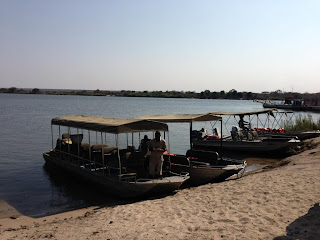









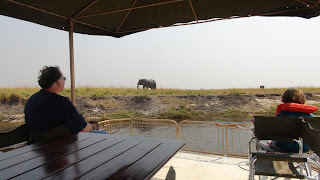

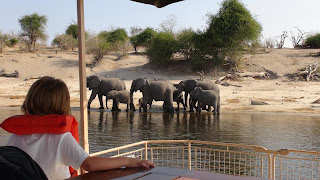











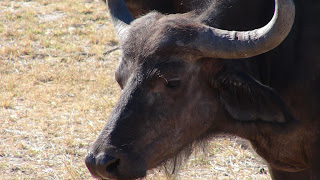




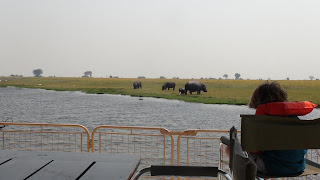















































What an amazing experience! You have really heightened my interest in visiting Africa!
ReplyDelete